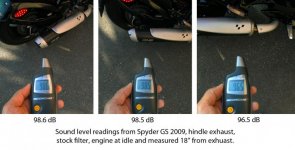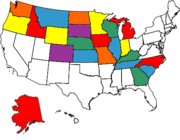StanTheMan
Member
I was curious about my local bylaw regarding motorcycle noise levels. I was only able to find a general statement for my area. (...must have an effective exhaust or intake muffling device in good working order and in constant operation").
In researching, I've discovered some municipalities clearly define acceptable noise levels for motorcycles.
in this example (92 dB):
http://www.town.caledon.on.ca/conte...aitems/2010-117MotorcycleNoiseby-lawFinal.pdf
Out of curiosity, I wanted to know the Hindle's noise level (I'm sure it's posted somewhere, but was unable to find it)...so I purchased a basic unit for $50.
http://www.thesource.ca/estore/product.aspx?product=1219799&language=en-CA
Here are my initial findings (98 db)* (see attached photo):

Accuracy of my $50 meter aside, the noise level fluctuated 10% depending on where I positioned the meter.
I've concluded my Hindle meets my local bylaw :thumbup:; but may not meet other, more restrictive municipal bylaws :lecturef_smilie:. Based on my limited observation, unless you are riding, acting or using an exhaust that attracts attention, LE are generally lenient on the exhaust noise.
Just thought I'd share. I hope this helps.
In researching, I've discovered some municipalities clearly define acceptable noise levels for motorcycles.
in this example (92 dB):
http://www.town.caledon.on.ca/conte...aitems/2010-117MotorcycleNoiseby-lawFinal.pdf
Out of curiosity, I wanted to know the Hindle's noise level (I'm sure it's posted somewhere, but was unable to find it)...so I purchased a basic unit for $50.
http://www.thesource.ca/estore/product.aspx?product=1219799&language=en-CA
Here are my initial findings (98 db)* (see attached photo):

Accuracy of my $50 meter aside, the noise level fluctuated 10% depending on where I positioned the meter.
I've concluded my Hindle meets my local bylaw :thumbup:; but may not meet other, more restrictive municipal bylaws :lecturef_smilie:. Based on my limited observation, unless you are riding, acting or using an exhaust that attracts attention, LE are generally lenient on the exhaust noise.
Just thought I'd share. I hope this helps.


